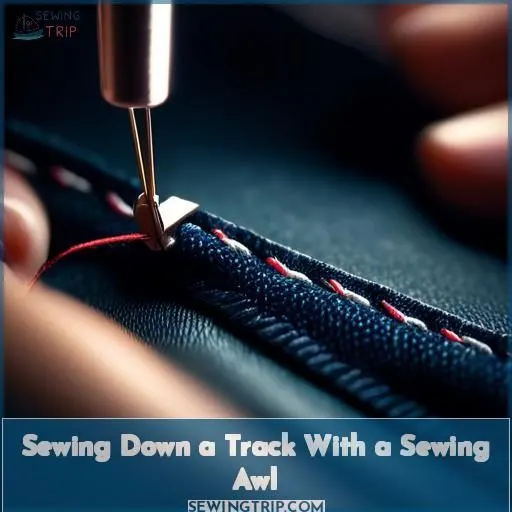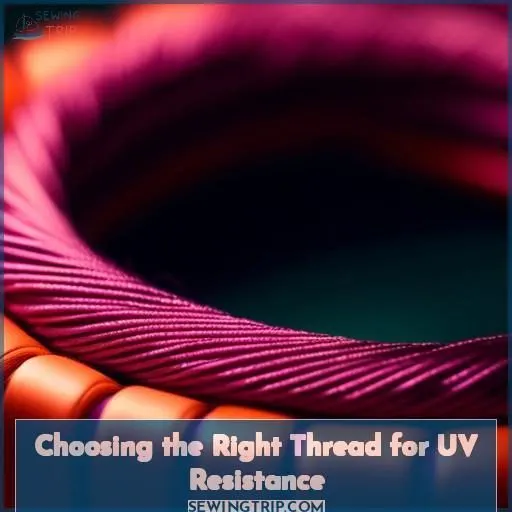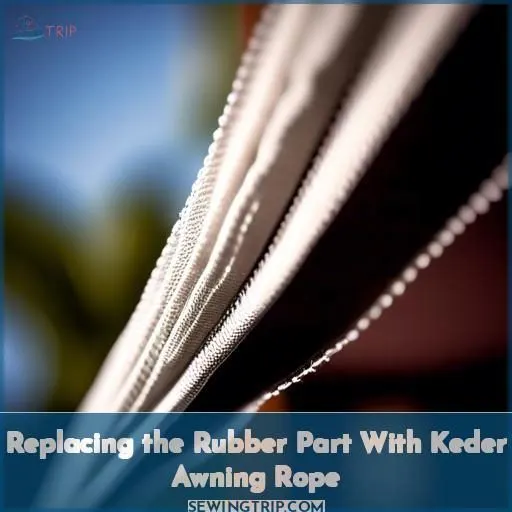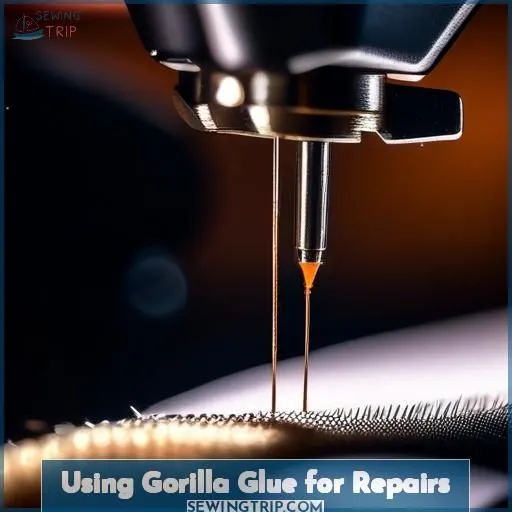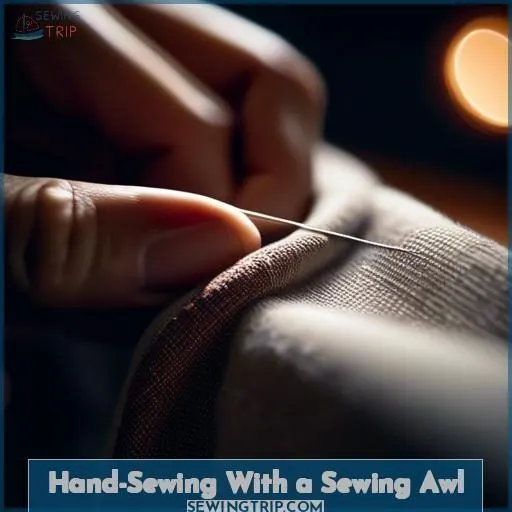This site is supported by our readers. We may earn a commission, at no cost to you, if you purchase through links.
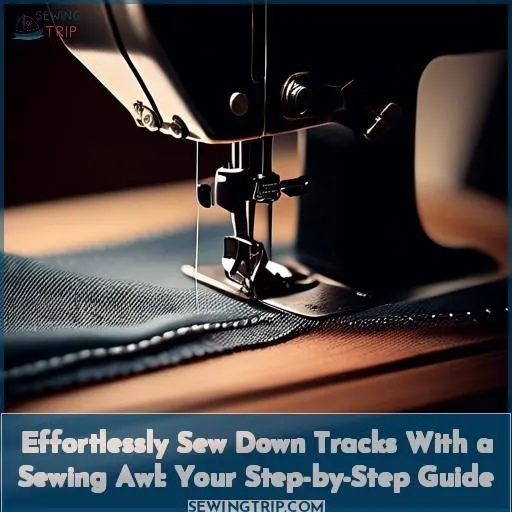
To effortlessly sew down a track, a speedy stitcher awl is your ideal tool. First, set up the awl and thread it with DaBond polyester for maximum UV resistance.
Then, use a relaxed grip and maintain good posture as you pierce the material, creating a smooth, secure stitch. Finish by tying a sturdy knot to lock the thread in place.
For added durability, consider replacing the rubber track with Keder awning rope – an affordable, UV-resistant solution. And if you need a stronger hold, a thin layer of Gorilla Glue can provide the adhesive power you’re seeking.
Table Of Contents
Key Takeaways
- To sew down a tarp effectively, use a Speedy Stitcher awl threaded with DaVinci polyester for its UV resistance and durability.
- Maintain a relaxed grip and good posture while piercing the material with the awl to create smooth, secure stitches.
- For enhanced durability, consider replacing the rubber tarp with Keder awning rope, which is affordable and UV-resistant.
- If a stronger hold is needed, applying a thin layer of Gorilla Glue can provide additional adhesive strength to the repair.
How to Sew Down a Track?
To sew down a track, you can use a sewing awl, which works like a hand-held sewing machine. This tool is great for quick repairs to straps, bags, and other stitched objects.
The Speedy Stitcher Sewing Awl Kit includes a sewing awl, straight needle, curved needle, and thread. It’s also useful for canvas or leather repairs and can be used for outdoor and camping equipment, awnings, tents, saddles, and harnesses.
Sewing Down a Track With a Sewing Awl
Using a Speedy Stitcher Awl, you can easily sew down tracks by setting up the awl properly. Once you’ve finished the stitch, be sure to store the awl safely to avoid any accidents.
Using a Speedy Stitcher Awl for Manual Sewing
When your awning rope decides to slide out and retire, grab your Speedy Stitcher Awl—it’s time to stitch things up! Imagine using a curved needle to weave strength back into your awning’s fabric. Here’s a quick tip:
- Using sharp awl: Pierces easily, no need to muscle through.
- Dabond polyester thread: Resists rot, basks in the sun.
- Needle lubricant: Slides through like butter, no snagging.
Setting Up the Awl for Sewing
To prepare your awl for sewing, you’ll need to account for the awl needle size and thread thickness. Adjust the tension accordingly and wind the bobbin correctly.
Once you’re ready to sew, make sure your awning bag is secure and the c-channel is aligned. For optimal results, use Keder awning rope, which is easy to sew and offers UV resistance.
Remember to store your awl safely when not in use.
Finishing the Stitch and Storing the Awl Safely
- Tie a knot: Tie a knot at the end of the thread to secure the stitch.
- Trim excess thread: Trim the excess thread close to the knot.
- Store the awl safely: Store the awl in a protective case or pouch to prevent damage.
Choosing the Right Thread for UV Resistance
You’ll want to use Dabond polyester thread for your outdoor awning repair project. This UV-resistant thread will guarantee your stitches withstand the harsh sunlight without decaying over time.
Dabond Polyester Thread for Outdoor Projects
For your outdoor projects, Dabond polyester thread is an excellent choice for UV resistance. This thread, suitable for home sewing, is specifically designed for outdoor applications. It’s strong, durable, and resistant to the sun’s harmful rays.
When using Dabond polyester thread, you can trust that your work will withstand the elements. Its resistance to UV radiation guarantees that your projects will last, even when exposed to the sun.
UV-resistant Thread for Awning Repair
Regarding UV resistance for awning repairs, there are various choices to contemplate. For example, you can employ Dabond polyester thread, renowned for its UV-resistant attributes. Alternatively, you can substitute the rubber awning rope with Keder awning rope, which is also UV-resistant and more manageable to sew.
Additionally, Gorilla glue can be utilized for repairs, although it may not offer the same level of UV resistance as thread or Keder rope.
Selecting the Appropriate Thread for the Project
After delving into the realm of UV-resistant threads, it’s time to haul in the ideal choice for your project. The appropriate thread type encompasses more than UV protection; it’s a delicate equilibrium of resilience, expenditure, and accord.
Envision your sewing machine as a loyal vessel traversing the boundless expanse of selections. Like locating the celestial guide, it illuminates your path to sewing triumph.
Replacing the Rubber Part With Keder Awning Rope
Replacing the rubber awning rope with Keder rope offers several advantages. Keder rope is inexpensive, easy to sew, and can be used with a home sewing machine, making it an excellent choice for preventing further separation of your awning.
Benefits of Using Keder Awning Rope
Discover the benefits of using Keder awning rope for your awning repair. In addition to providing enhanced strength and durability, it’s also simple to install and compatible with a home sewing machine. Keder rope offers UV resistance, ensuring that your awning remains shielded from the sun. Replace rubber awning rope with a more dependable and enduring solution.
Replacing the Rubber Awning Rope With Keder Rope
Replacing your old rubber awning rope with Keder rope is an excellent choice for awning repairs. Keder rope is inexpensive, easy to sew, and can be used with a home sewing machine. It prevents further separation and is a cost-effective solution for awning rope replacement.
When installing Keder rope, consider the timing and the durability of polyester thread for UV resistance. Use a sewing awl like the Speedy Stitcher Awl for manual sewing, ensuring a strong and secure connection.
Advantages of Keder Rope for Awning Repairs
Keder rope offers several advantages for awning repairs. Its strength and durability make it a reliable replacement for rubber awning ropes. Additionally, Keder rope is UV-resistant, ensuring that the awning remains protected from the sun’s harmful rays.
The cost-effectiveness of Keder rope is another advantage, as it’s inexpensive and easy to sew. Moreover, its ease of installation allows for a quick and efficient repair process.
Using Gorilla Glue for Repairs
Gorilla Glue can be a practical repair solution for your awning issues. However, you’ll want to thoughtfully evaluate the pros and cons of using glue, and adhere to some essential guidelines to guarantee a successful awning repair.
Gorilla Glue as a Repair Option
Gorilla glue is a sought-after option for awning repairs because of its robust adhesive and lasting durability. Nonetheless, it’s crucial to take into account the glue’s lifespan, particularly when exposed to sunlight. Here’s a concise guide on utilizing Gorilla glue for awning repairs:
- Clean the surface: Remove any dirt or debris from the awning track and the rubber component.
- Apply glue: Use a brush or a glue gun to apply a thin layer of Gorilla glue to the rubber component.
- Position the parts: Press the rubber component back into the metal track and hold it in place for a few minutes.
- Allow the glue to cure: Adhere to the manufacturer’s instructions for curing time.
Advantages and Limitations of Using Glue
Applying Gorilla Glue for awning repairs offers various benefits, but it also has some drawbacks. Let’s delve into the advantages and disadvantages of using this adhesive for your awning restoration project.
Advantages:
- Rapid Setting: Gorilla Glue sets quickly, which is advantageous when you need to repair your awning promptly.
- Durable Bond: The glue forms a lasting bond that remains pliable after washing, guaranteeing the repair’s longevity.
- UV Resistance: Gorilla Glue is designed to bond fabric and hard-to-hold embellishments, making it suitable for outdoor projects that require UV protection.
- Curing Time: The glue has a minimum curing time of 24 hours for complete curing, allowing you to use your awning again without compromising the bond.
Limitations:
- Surface Preparation: Adequate surface preparation is essential for the adhesive to perform effectively. Make sure the surfaces to be bonded are clean and free of impurities.
- Bonding Strength: Although Gorilla Glue is robust, it mightn’t be as strong as other adhesives like Dabond polyester thread or Keder awning rope for awning repair.
- UV Resistance: While Gorilla Glue is UV-resistant, it may not be as effective as Dabond polyester thread or Keder awning rope in preventing further separation of the awning.
To enhance the bond strength of Gorilla Glue, follow these steps:
- Test the adhesive on a spare piece of the target fabric.
- Pre-wash the fabric without using fabric softener.
- Apply the adhesive to each surface to be bonded.
- Wait approximately two minutes for the adhesive to partially dry before attaching the materials.
- Press the materials firmly together.
- Allow a minimum of 24 hours for complete curing.
- Wait a minimum of three days before washing and ironing.
Tips for Using Gorilla Glue for Awning Repairs
After investigating the glue option, let’s delve into Gorilla Glue‘s capabilities for your awning repairs. Its superior performance relies on appropriate application methods. Verify compatibility with awning materials by conducting a patch test.
For durability assessment, adhere a small area and monitor. Bear in mind, proper storage and handling maintain the glue’s effectiveness.
A small amount can achieve significant results, so apply moderately for a precise, robust repair.
Hand-Sewing With a Sewing Awl
Hand-sewing with a Speedy Stitcher awl can be an effective way to sew down awning tracks. By mastering the techniques for using this specialized tool, you’ll be able to tackle even the most stubborn awning repairs with confidence.
Techniques for Hand-sewing With a Sewing Awl
Hand-sewing with a sewing awl can be a tedious task, but with the right techniques, it can be a breeze. Start by selecting the appropriate awl needle type for your project. For awning repairs, consider using a speedy stitcher awl.
Before you start sewing, apply thread waxing techniques to guarantee a smooth and even stitch. For comfort, grip the awl with a relaxed hand and maintain proper posture.
After finishing the stitch, store the awl safely to prevent damage. For awning fabric reinforcement, consider using Dabond polyester thread for UV resistance.
Tips for Using a Speedy Stitcher Awl for Sewing
To master using a speedy stitcher awl for sewing, start by selecting the right thread for your project. For UV resistance, consider Dabond polyester thread.
Once you’ve chosen your thread, set up your awl and finish the stitch securely. Remember to maintain your awl and store it safely after use.
With practice, you’ll become an expert at hand-sewing with a speedy stitcher awl, ensuring your awning repairs are exceptional.
Advantages of Hand-sewing for Awning Repairs
Hand-sewing with a sewing awl offers several advantages for awning repairs. Primarily, it allows for precise control over the stitching process, ensuring that the awning fabric is securely fastened to the track. This can lead to increased repair durability and thread strength.
Additionally, the manual process of hand-sewing with an awl can provide a sense of control and mastery for the repairer.
Moreover, using a UV-resistant thread, such as Dabond polyester, can enhance the longevity of the repair.
Finally, the awl’s design and handling can be customized to the specific needs of the awning fabric, ensuring a more effective and long-lasting repair.
Frequently Asked Questions (FAQs)
What is the recommended method for sewing down a track using a sewing awl?
Stitch that track like a pro, my friend! Grab your trusty Speedy Stitcher and let the sewing magic unfold. Weave that thread through the fabric, one precise stitch at a time, and watch your awning come back to life.
How can I ensure the thread used for UV resistance remains effective over time?
To maintain UV resistance, use Dabond polyester thread – it’s designed to withstand sun exposure. Stitch it up with your speedy stitcher and you’re good to go, no need to worry about fading or rot.
Is it possible to replace the rubber part of an awning with Keder awning rope?
Replacing the rubber awning rope with Keder rope is a straightforward swap. It’s a budget-friendly fix that’ll keep your awning securely in place and prevent further separation. Give it a shot – you got this!
Can Gorilla glue be used for awning repairs, and if so, what is the best method?
Gorilla glue is a godsend for awning repairs! Just slather it on like frosting and watch your awning come back to life. But don’t get too heavy-handed – a little goes a long way. Smooth it out, let it dry, and you’re golden.
Is hand-sewing with a sewing awl the most effective method for repairing an awning bag?
Hand-sewing with a sewing awl is a painstaking, time-intensive process, but it’s the most practical way to mend an awning bag. The coated thread and bespoke tool enable a long-lasting, UV-resistant repair that will surpass other alternatives.
Conclusion
Mastering the art of sewing down tracks with a speedy stitcher awl is a game-changer for your awning repair and maintenance needs. With the right tools, materials, and techniques, you’ll sew down those tracks effortlessly, creating a smooth, secure stitch that stands the test of time.
Whether you’re replacing rubber with Keder rope or reinforcing with Gorilla Glue, this step-by-step guide equips you with the knowledge to sew down tracks like a pro, elevating the durability and longevity of your outdoor spaces.

